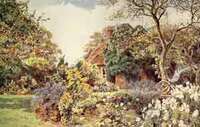There are Tree Peonies in the long border and the two others. It is difficult to grow them in my hot, dry, sandy soil, even though I make them a liberal provision of just such a compost as I think they will like. I have noticed that they do best when closely overshadowed by some other growing thing. In the two near beds there are some Mme. Alfred Carriere Roses that are trained to arch over to the angles, so as to comfort and encourage the Peonies. These beds have an informal edging of Stachys lanata, one of the most useful of plants for grey effects. Through it come white Tulips in irregular patches.
The long border has also Tree Peonies planted about two and a half feet from the edge. Partly to give the bed a sort of backbone, and partly to shelter the Tree Peonies, it has some bushes of Veronica Traversi {Veronica brachysiphon} and one or two Leycesteria formosa. In the middle of the length is a clump of Lilium giganteum and a biggish grouping of Dielytra spectabilis {Dicentra spectabilis}. All along the outer border there are patches and long straggling groups of the pretty dwarf Irises of the pumila, olbiensis and chamoe-iris sections, with others of the same class of stature and habit. Any bare spaces are filled with Wallflowers and Honesty in colours that accord with the general arrangement. The narrow border has mostly small shrubs, Berberis and so on, forming one mass with the hedge to the left, which consists of a double dry wall about four feet high, with earth between and a thick growth on the top of Berberis, Rosa lucida {Rosa pimpinellifolia var altaica} and Scotch Briers. Except the Berberis these make no show of flower within the blooming time of the spring garden, but the whole is excellent as a background.
Red primroses are in the narrow border next to the cross-wall; the wall here is much lower than the longer one on the right. The Primroses are grouped with the reddish-leaved Heuchera Richardsoni {Heuchera hispida}, the two together making a rich colour-harmony. Beyond them are scarlet Tulips. The small shaded rounds in this border and its continuation across the path into the near end of the main border are stout larch posts supporting a strong growth of Rose Mme. Alfred Carriere and Clematis montana. These have grown together into a solid continuously intermingling mass, the path at C passing under a low arch of their united branches. The high wall on the right is also covered with flowering things of the early year, Morello Cherries, Rubus deliciosus and Clematis montana, some of this foaming over from the other side of the wall.
The wall is a part, about a third of the length, of the high wall that protects the large border of summer and autumn flowers from the north, and that forms the dividing-line between the pleasure garden proper and the working garden beyond.

